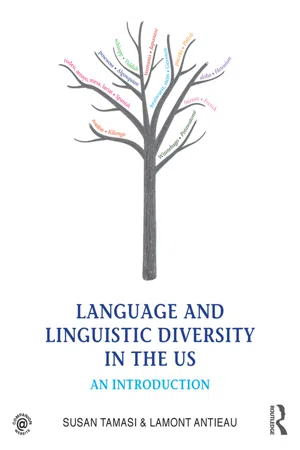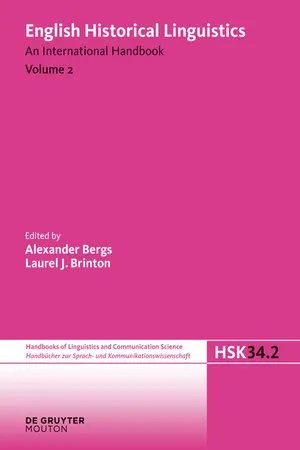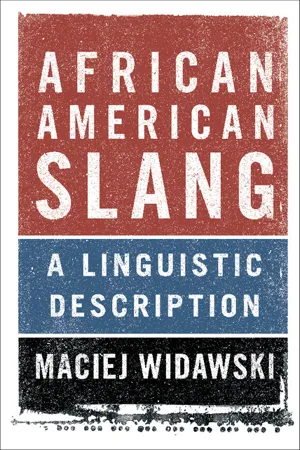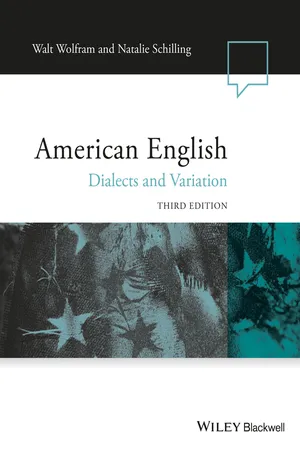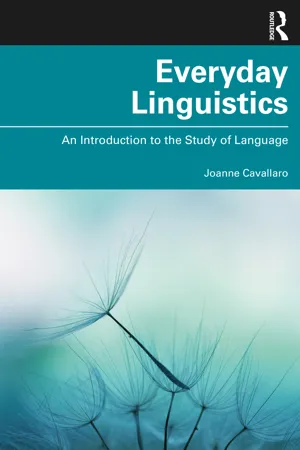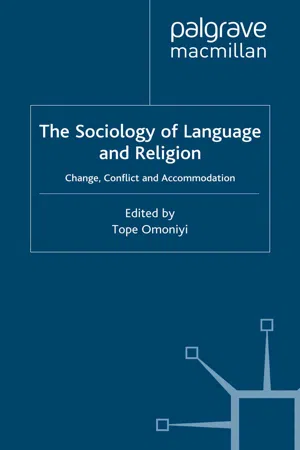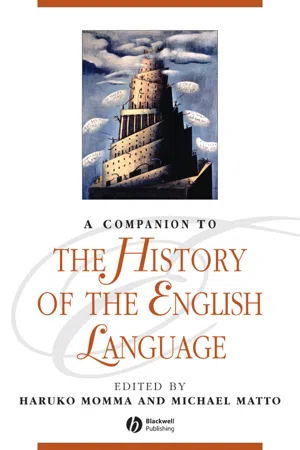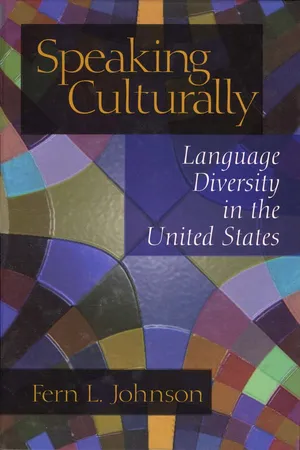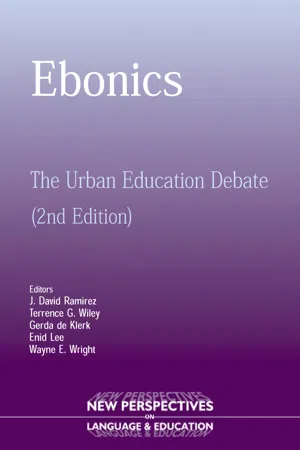Languages & Linguistics
African American English
African American English (AAE) is a variety of English spoken by many African Americans in the United States. It has distinct phonological, grammatical, and lexical features that differentiate it from Standard American English. AAE is a rich and dynamic linguistic system with its own rules and conventions, and it plays a significant role in the cultural and social identity of African American communities.
Written by Perlego with AI-assistance
Related key terms
1 of 5
11 Key excerpts on "African American English"
- eBook - ePub
Language and Linguistic Diversity in the US
An Introduction
- Susan Tamasi, Lamont Antieau(Authors)
- 2014(Publication Date)
- Routledge(Publisher)
Over the last five decades, a body of work, impressive in both academic rigor and sheer number of publications, has been produced, and newer, more focused discussions continue to be published regularly (see Alim & Baugh, 2007, on AAE and educational policy; Lanehart, 2009, for intersections of gender and ethnicity; and Green, 2011, for language acquisition and the complexity of AAE structure). And suffice it to say, even though a plethora of research has been conducted on the topic, culminating in many scholarly publications, there is still much to learn about this linguistic system and its role in both American speech and the African American community. Many questions about AAE have yet to be answered, some can never be answered, and there are even those whose answers are considered to be highly controversial. However, new paths of research are continually being forged and hidden resources are being revealed. Like the linguistic system itself, the study of AAE is always changing.A ROSE IS A ROSEIn this textbook, we have chosen to use the term African American English , or AAE , in reference to this particular linguistic variety, despite that it is not the only name that has been applied to this system, nor is it the only one in current use. Below is a list of alternate names for AAE that have been used in the linguistic literature; the list is not exhaustive:• African American Vernacular English, or AAVE (AAVE itself can be pronounced in one of three ways: by its initials A-A-V-E; with two syllables [a:vei]; or with one syllable [æv]);• African American Language;• Black Vernacular English;• Black English Vernacular;• Black Language;• Black Street Speech;• Black Talk;• Ebonics;• Negro English;• Pan African Communication;• Spoken Soul.The names used to describe linguistic varieties are often a reflection of the location, identity, or history of their speakers during their development and/or an indication of their connections to other languages and dialects. For example, the name American English used for the general speech of the United States represents not only the location of its use and dialectal development (American ) but also its sociohistorical and linguistic ties to England and the language that developed there (English ). In this example, the name also sets up a contrast to other national forms of English, such as British, Canadian, Australian, and Indian.Many of the names listed above reflect these issues and, due to the inclusion or exclusion of specific terms, different names highlight different concepts. Consciously or not, these names indicate distinctive aspects of AAE’s history or structure and, in some instances, they even index divergent research paradigms. For example, AAE has close connections to the American South, but it is not referred to as Southern American English , as that term is reserved for another linguistic variety. Instead, ethnic identity and a connection to the history of Africans in America appear to be the most salient factors reflected in these names and, for some of the terms listed above, the name also reflects historical changes in referencing ethnicity in the United States, such as the use of Black, African American , or Negro - eBook - PDF
- Alexander Bergs, Laurel J. Brinton, Alexander Bergs, Laurel J. Brinton(Authors)
- 2012(Publication Date)
- De Gruyter Mouton(Publisher)
I choose to define AAL in agreement with Mufwene (2001: 21): “African American English (AAE) is English as spoken by or among Afri-can Americans” because “[a] language variety is typically associated with a community of speakers and, in many communities, a language means no more than the particular way its members speak”. For example, if we look up “Italian” in a dictionary, it is de-fined as “of or pertaining to Italy, its people, or their language; a native or inhabitant of Italy, or a person of Italian descent” (http://www.dictionary.com). Mufwene is saying that we can define AAL in the same way: “of or pertaining to African Americans; a per-son of African American descent”. Given this definition, AAL is the umbrella term for all ways of language use of African Americans – including Gullah and African Amer-ican Vernacular Language (AAVL). In my classes, I describe AAL as the umbrella cov-ering all its varieties across the US and Canada where African Americans are. That means it covers West Coast AAL, East Coast AAL, Southern AAL, Gullah, AAVL, and everything in between. The Anglicist position purports that Africans in America learned regional varieties of British English dialects from British overseers with little to no influence from their own native languages and cultures. This position emerged in the mid 20th century and is in opposition to the Creolist position. Anglicists use ex-slave recordings and texts (see Bailey et al. 1991) as well as comparisons to other historical texts, British varieties, and slave resettlement in the Americas to support their position. More current is the belief that non-standard varieties of British English are the precursors of AAL as op-posed to standard ones since the whites that slaves would have had contact with would have spoken non-standard varieties of British English instead of standard varieties (i.e., Neo-Anglicist). - eBook - PDF
African American Slang
A Linguistic Description
- Maciej Widawski(Author)
- 2015(Publication Date)
- Cambridge University Press(Publisher)
The following are occasionally encountered as well: Black Dialect, Black Accent, Ghetto Speech, Jive Talk and Hip-Hop Talk. Most of these terms are used more or less interchangeably, but their meanings do not always overlap. It is thus necessary to introduce appropriate terminological distinctions. African American Vernacular English (alternatively termed African Ameri- can English, AAVE or AAE) is a fairly recent term from the late 1980s, currently used most widely among linguists (Rickford 1999: xxi). It is also the broadest and most general term. Baugh (in McArthur 1996: 133) defines it as a variety of “English used by a majority of US citizens of Black African background.” As any variety of English, it has specific phonological, lexical and syntactical components; although distinct from standard American English, it is rule-governed and characterized by logical and structural integrity. How- ever, AAVE is not homogeneous, but then again, neither is the speech of white Americans. Moreover, not all African Americans speak it: there may be those whose speech does not differ in any special way from general American English, just as there may be those who can shift from one variety of English to the other, depending on the context. Note that when the nominal element “English” is dropped, the term may be used in another meaning, referring to African American speech considered as a language separate from English, although derived from it in the process of decreolization. Afro-American Vernacular English (alternatively termed Afro-American English) is the synonymous predecessor of AAVE, used especially often in 1.1 Terminology 3 - eBook - ePub
American English
Dialects and Variation
- Walt Wolfram, Natalie Schilling(Authors)
- 2015(Publication Date)
- Wiley-Blackwell(Publisher)
The Oxford Handbook of African American Language. Oxford: Oxford University Press. This comprehensive collection includes chapters by the prominent researchers on African American Language from a variety of perspectives and covers a wide array of topics, ranging from issues of definition and description to applying linguistic knowledge to societal issues. The volume includes excellent overviews of the past and present status of African American speech.- Rickford, John R. (1999) African American Vernacular English: Features, Evolution, Educational Implications. Oxford: Blackwell. This book offers a comprehensive treatment of a wide range of AAE structural features, the historical development of AAE, and the implications of the study of AAE for education. The collection represents over two decades of informed research by one of the leading AAE researchers in the field. Rickford presents a modified creolist position on the origin and early development of AAE.
- Rickford, John R., and Russell John Rickford (2001) Spoken Soul. New York: John Wiley and Sons, Inc. This book is a highly engaging account of AAE for readers with no background in linguistics. The authors consider the history and current status of AAE, as well as its use in literature and the media.
- Wolfram, Walt, and Erik R. Thomas (2002) The Development of African American English. Oxford: Blackwell. This book provides a description of a unique, insular bi-racial community existing in coastal North Carolina for almost three centuries, with implications for the general development of earlier and contemporary AAE.
References
- Alim, H. Samy (2004) You Know My Steez: An Ethnographic and Sociolinguistic Study of Styleshifting in a Black American Speech Community. Durham, NC: Duke University Press.
- Bailey, Guy (2001) The relationship between African American Vernacular English and White vernaculars in the American South: A sociocultural history and some phonological evidence. In Sonja L. Lanehart (ed.), Sociocultural and Historical Contexts of African American English
- eBook - ePub
Everyday Linguistics
An Introduction to the Study of Language
- Joanne Cavallaro(Author)
- 2023(Publication Date)
- Routledge(Publisher)
Chapter 12 in the discussion of multilingual education.CHAPTER SUMMARY- African American Language, which has been called by various names over the years, is a variety of American English widely spoken across the United States. It has been a part of American history and culture from the beginning. It is estimated that 80%–90% of African Americans speak some variety of AAL.
- Linguists generally agree that its origins lie in the languages of Africa brought over by those who were enslaved, in the English varieties those enslaved peoples were exposed to, and in the creoles of enslaved peoples brought here from the Caribbean.
- Its history is closely connected to the history of those who speak it, including their experiences as enslaved peoples and as victims of discrimination.
- As with all varieties of all languages, AAL is rule governed; those who view those rules as instances of bad grammar are mistaken.
- Although the pronunciation of ask as [æks] is unjustly stigmatized, that pronunciation has a history that goes back to Old English.
- Language is connected to race in multiple and complex ways; it is both tied to our ethnoracial identity and used as a way of constructing or shaping our identities.
- Variation within AAL is related to gender, socioeconomic class, and local contexts.
- Micro-aggressions are a form of covert linguistic discrimination. Such covert discrimination can also take place in the classroom when AAL is presented as not appropriate for school or other important settings.
KEY TERMS- invariant be
- zero copula
- existential it is
- African American Women’s Language
- Ebonics
- micro-aggressions
- linguistic discrimination
- variation within AAL
EXPLORATIONSExploration 1: Short writing assignment
This is a fictional letter written to the Linguistics Society of America, based on a real letter written as an editorial. Dear Sirs and Madams,I write to you today in frustration and confusion. I was taught that there is a right way and wrong way to speak English. Yet around me I hear utterances that seem to break all the rules of English, especially from inner city Black youth. And I hear experts such as you say, “This is their dialect. It is rule-governed just like every other language variety.” I simply do not believe it. If you listen to how they speak, I’m sure you’ll agree with me; there are no rules. - eBook - PDF
The Sociology of Language and Religion
Change, Conflict and Accommodation
- Tope Omoniyi(Author)
- 2010(Publication Date)
- Palgrave Macmillan(Publisher)
The subsequent section examines how African Americans use AAVE to project their ethnic identity in the sacred arena of religion. The penultimate section discusses African 192 The Sociology of Language and Religion Americans’ attitudes towards AAVE. The last section addresses briefly how attitudes toward AAVE impact the debates on the role of AAVE in the schooling of African American children. AAVE: a brief social history AAVE, also known as African American English, Black dialect, Black/African American Lingo, Black English, African Negro Non-Standard English, Black English Vernacular , African American Language, African Language Systems, Pan African Communicative Behaviours, Noble Language of the Ghetto or Ebonics (Filmer 2003, Smitherman 1977, 1998, 2002 [1973]), has argu- ably attracted far more attention from researchers, theorists and the public in general than any other ethnic variety of American English. Of all the afore-listed terms, Ebonics and AAVE have become more popular in recent years. The conceptual framework of Ebonics, originally proposed in 1973 by Robert Williams, a psychologist, and subsequently endorsed by black scholars, ‘represented an avenue for decolonization of the African-American mind, a way to begin repairing the psycholin- guistically maimed psyche of Blacks in America’ (Smitherman 1998: 30). According to Williams (1975), the term ‘Ebonics’ means ‘black speech sounds’. It is a blend derived from ‘ebony’, meaning black, and ‘phonics’, meaning sound. Williams and Rivers (1975: 100–1) define Ebonics as the linguistic and paralinguistic features which on a concentric con- tinuum represent the communicative competence of West African, Caribbean, and United States slave descendants of African origin. Ebonics includes the various idioms, patois, argots, ideolects [sic!] and social dialects of these people. It is thus the culturally appropri- ate language of black people and is not to be considered deviant. - eBook - PDF
- Matthew J. Gordon(Author)
- 2012(Publication Date)
- Bloomsbury Academic(Publisher)
The term “Nonstandard Negro English” that appeared in early studies gave way to “Black English Vernacular” (or “Black Vernacular English”) in the 1970s and 1980s. Eventually that too gave way to “African American Vernacular English” or AAVE. 1 Many scholars today prefer “African American English,” as a general label. Labov sees the latter as appropriate for referencing the “wide range of grammatical and phonological features” in the speech of African Americans, but he uses “African American Vernacular English” to designate “the geographically uniform grammar found in low-income areas of high residential segregation” (2010, p. 348). 2 This usage is in keeping with his theories on stylistic variation where “vernacular” describes a particular variety that occupies the end of a continuum opposite the standard language (see Chapter Five). I will use “African American Vernacular English” or AAVE throughout this chapter since that term predominates in Labov’s writing on the subject. LABOV 194 Definitionally, AAVE clearly constitutes a social dialect of American English. It has received more scholarly attention than any other social dialect in the US, and for good reason. While AAVE shares many phonological and grammatical features with other dialects, most notably with southern white speech, it also involves usages that are more exclusive. For example, in many dialects of English around the world, ain’t is used in contexts where Standard English would use a negated form of have or be (e.g. We ain’t seen him . ~ We haven’t seen him ; He ain’t here . ~ He isn’t here .). These usages appear in AAVE as well, but speakers of this dialect may also use ain’t where others would use didn’t (e.g. We ain’t go . ~ We didn’t go .), something not found in most other varieties. Linguists have documented a long list of features found in AAVE. - Haruko Momma, Michael Matto, Haruko Momma, Michael Matto(Authors)
- 2009(Publication Date)
- Wiley-Blackwell(Publisher)
Thereby the present-day hip-hop discourse and rap-genre have become linguistic rebels. Their rebellion has furthered the distinctive linguistic difference of AAVE. If viewed through a post-colonial perspective, it is evident that AAVE may well have been the colonized Afri-cans’ means of restructuring a language that had been imposed on them by the colonizer. As the African American community developed, members increasingly utilized their own version of that language to assert their community “as the central, generating force of power, language, and self-identification” (Zeigler & Osinubi 2002: 593). African Americans “flipped the script” on the intentional bias exerted toward them through their language and used it as a motivator rather than a terminator. Speakers within that community are motivated to maintain that linguistic kinship through heritage, identity, and language politics. Conclusion Ultimately, despite the arguments concerning its origin, the questions about its gram-maticality, and controversies regarding its use in education, African American Ver-nacular English has developed as a native American variety. Due to its history of migration and because of its internal community motivators of heritage, identity, and linguistic pride, it has maintained a distinctive speech community unified by cultural difference. That stability of difference has preserved an African American speech com-munity and asserted a cultural and linguistic self. African American Vernacular English 519 References and Further Reading African American Mosaic: A Library of Congress Resource Guide for the Study of Black History and Culture. (2006). Library of Congress. www. loc.gov/exhibits/african/afam008.html. Baratz, J. & Shuy, R. (eds.) (1969). Teaching Black Children to Read . Washington, DC: Center for Applied Linguistics. Baugh, J. (1999). Out of the Mouths of Slaves: African American Language and Education Malpractice . Austin: University of Texas Press. Burling, R. (1973).- eBook - PDF
Speaking Culturally
Language Diversity in the United States
- Fern L. Johnson(Author)
- 1999(Publication Date)
- SAGE Publications, Inc(Publisher)
In Dillard's (1985) social history of American English, he singles out the dialect of blacks in the United States as strikingly the most distinc-tive among American English speakers, especially when one considers that it has a very wide geographic distribution and that its history does not show any special localization at any time in the past (p. 95). As such, African American English provides an important example of linguistic and commu-nicative vitality in a larger context of considerable negative valuation by the majority white cultures surrounding it. For many (although certainly not all) African Americans, to be African American means to speak (at least some of the time) the present-day linguistic variety that makes claim to both the memory and present vitality of African American people in a national context where race matters. Even for the seemingly fully integrated professional African American, use of particular phonological or syntactic forms can speak volumes about his or her own sense of identity and the larger connec-tions to communities not literally present in many of that person's daily experience. I am continuously struck, for example, by how many African American speakers present their academic talks in some version of MAE but then clearly move to a variety recognizable as African American English during some portion of the question-answer period. From the perspective of modes of discourse too, the historical continuities are heard through the retention and creative modification in the voices of African Americans. Cultural abstraction—the stuff of how people think about the world—elaborated into cultural institutions and systems of expres-siveness in artifacts all interrelate and mutually support the discourse pat-terns considered in this chapter. For many African Americans, these modes of discourse are the primary discourses of daily life. - eBook - PDF
The Workings of Language
From Prescriptions to Perspectives
- Rebecca S. Wheeler(Author)
- 1999(Publication Date)
- Praeger(Publisher)
The statement it re- leased may have been wordy, diffuse, and filled with bad bureaucratese and pompous-sounding references to "African Language Systems," but the in- tent was clear enough: the board wanted to acknowledge that AAVE was distinct in certain respects from Standard English, and it proposed to be responsive to the educational implications. Buried among the jargon of the announcement was a mention of a name for AAVE, suggested by a Black scholar in 1975 but never adopted by linguists: Ebonics. That word, concocted from ebony (a color term from the name of a dark-colored wood) and phonics (the name of a method for teaching reading), was destined to attach to the board as if chiseled into a block of granite and hung round their necks. They would never hear the end of it. One problem with the name was that it lent itself irresistibly to stupid puns and jokes. The Economist picked it up and printed a brief story headed "The Ebonics virus," a tasteless reference to the then-recent out- break of the horrible Ebola fever in Zaire (the subliminal link: nasty things out of Africa). People rapidly invented other -onics words to mock the idea of letting African Americans have their own claim to a language. Would Jewish people propose that their way of speaking English should be des- ignated Hebonics? Could stupid people complain that they were vie- African American Vernacular English 41 tims of their native language, Moronics? Cartoonists seemed to find such possibilities endlessly amusing, and the jokes kept coming for more than a year. But I will not be primarily concerned here with analysis of the politics and the rhetoric that the "Ebonics" story provoked. I will be concerned with AAVE itself, the everyday speech of millions of people in largely seg- regated African American districts. The majority of English speakers think that AAVE is just English with two added factors: some special slang terms and a lot of grammatical mistakes. - eBook - PDF
Ebonics
The Urban Education Debate
- David J Ramirez, Terrence Wiley, Gerda de Klerk, Enid Lee, Wayne E. Wright(Authors)
- 2005(Publication Date)
- Multilingual Matters(Publisher)
Most nonstandard features in Black English are directly traceable not to Mende, Yoruba, or Kikongo but to regional dialects spoken by the British settlers whose English was what African slaves in America were exposed to . . . At best, African influence on Black English is largely restricted to intonation, some vocabulary items (most of them obsolete in urban culture) and patterns of social usage. Thus, even though there are some non-Africologist language research-ers and scholars who do acknowledge the existence of West and Niger-Congo African features in the speech of African Americans and Africans in the Caribbean and Latin American Diaspora today, most do not regard this as evidence that the language or dialects of descendants of enslaved Africans in Diaspora are neo-African dialects and languages. Instead they contrive all kinds of specious arguments to support the white cultural hegemonic thesis that the base from which the native language of African Americans derives is English. Ironically, the pidgin/creolists use grammar as their criterion to classify English as belonging to the Germanic language family and then vacillate from this criterion and use the parent language from which the bulk of the vocabulary or lexicon is derived to classify the language of descendants of enslaved Niger-Congo Africans as a BE dialect. The Generative Grammarians or Dialectologists contend that the grammar and the bulk of the vocabulary of the descendants of enslaved Africans’ language is entirely derived from nonstandard British settler English and that even the African elements that can be found are not African retentions but rather are African features that were borrowed by the European settlers who then transmitted these African features to the enslaved Africans. Contrarily, the Africologists see the base of AAE as West African Niger-Congo languages, using genesis classification as the means to present their argument.
Index pages curate the most relevant extracts from our library of academic textbooks. They’ve been created using an in-house natural language model (NLM), each adding context and meaning to key research topics.
